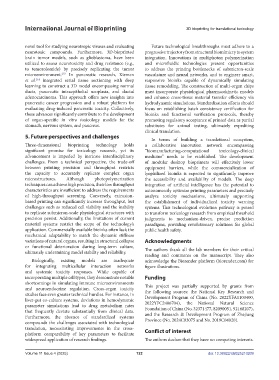Page 130 - v11i4
P. 130
International Journal of Bioprinting 3D bioprinting for translational toxicology
novel tool for studying neurotropic viruses and evaluating Future technological breakthroughs must adhere to a
neurotoxic compounds. Furthermore, 3D-bioprinted progressive trajectory from structural biomimicry to system
brain tumor models, such as glioblastoma, have been integration. Innovations in multiphoton polymerization
utilized to assess neurotoxicity and drug resistance (e.g., and microfluidic technologies present opportunities
to temozolomide) by precisely replicating the tumor to address the printing bottlenecks of submicron-scale
microenvironment. In pancreatic research, Kiemen vasculature and neural networks, and to engineer smart,
213
et al. integrated serial tissue sectioning with deep responsive bioinks capable of dynamically simulating
214
learning to construct a 3D model encompassing normal tissue remodeling. The construction of multi-organ chips
ducts, pancreatic intraepithelial neoplasia, and ductal must incorporate physiological pharmacokinetic models
adenocarcinoma. This approach offers new insights into and enhance cross-tissue material transfer efficiency via
pancreatic cancer progression and a robust platform for hydrodynamic simulations. Standardization efforts should
evaluating drug-induced pancreatic toxicity. Collectively, focus on establishing batch consistency certification for
these advances significantly contribute to the development bioinks and functional verification protocols, thereby
of organ-specific in vitro toxicology models for the promoting regulatory acceptance of printed data as partial
stomach, nervous system, and pancreas. substitutes for animal testing, ultimately expediting
clinical translation.
5. Future perspectives and challenges
In terms of building a translational ecosystem,
Three-dimensional bioprinting technology holds a collaborative innovation network encompassing
significant promise for toxicology research, yet its “biomanufacturing-computational toxicology-clinical
advancement is impeded by intricate interdisciplinary medicine” needs to be established. The development
challenges. From a technical perspective, the trade-off of modular desktop bioprinters will effectively lower
between printing precision and throughput restricts equipment barriers, while the commercialization of
the capacity to accurately replicate complex organ lyophilized bioinks is expected to significantly improve
microstructures. Although photopolymerization the accessibility and availability of models. The deep
techniques can achieve high precision, their low throughput integration of artificial intelligence has the potential to
characteristics are insufficient to address the requirements autonomously optimize printing parameters and precisely
of high-throughput screening. Conversely, extrusion- analyze toxicity mechanisms, ultimately supporting
based printing can significantly increase throughput, but the establishment of individualized toxicity warning
challenges such as reduced cell viability and the inability systems. This technological evolution pathway is poised
to replicate submicron-scale physiological structures with to transform toxicology research from empirical threshold
precision persist. Additionally, the limitations of current judgments to mechanism-driven, precise prediction
material systems restrict the scope of the technology’s paradigms, providing revolutionary solutions for global
application. Commercially available bioinks often lack the public health safety.
mechanical adaptability to match the dynamic stiffness
variations of natural organs, resulting in structural collapse Acknowledgments
or functional deterioration during long-term culture,
ultimately undermining model stability and reliability. The authors thank all the lab members for their critical
reading and comments on the manuscript. They also
Biologically, existing models are inadequate acknowledge the Biorender platform (biorender.com) for
for integrating multicellular interaction networks figure illustrations.
and systemic toxicity responses. While capable of
incorporating multiple cell types, they demonstrate notable Funding
shortcomings in simulating immune microenvironments This project was partially supported by grants from
and neuroendocrine regulation. Cross-organ toxicity the following sources: the National Key Research and
studies face even greater technical hurdles. For instance, in Development Program of China (No. 2022YFA1103400,
liver-gut co-culture systems, deviations in hemodynamic 2022YFC2406704), the National Natural Science
parameter simulations lead to drug metabolism rates Foundation of China (No. 32371477, 82090051, 92168207),
that frequently deviate substantially from clinical data. and the Research & Development Program of Zhejiang
Furthermore, the absence of standardized systems Province (No. 2024C03075 and No. 2019C04020).
compounds the challenges associated with technological
translation, necessitating improvements in the cross- Conflict of interest
platform comparability of key parameters to facilitate
widespread application of research findings. The authors declare that they have no competing interests.
Volume 11 Issue 4 (2025) 122 doi: 10.36922/IJB025210209

